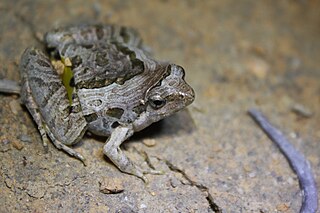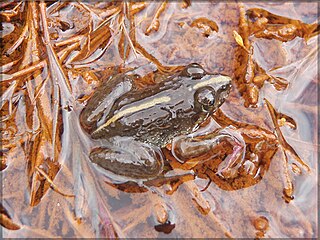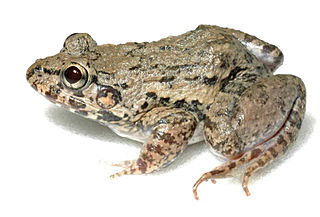The nonsense rat, Nicobar Archipelago rat, or Miller's Nicobar rat is endemic to the Nicobar Islands in India. It is found on Great Nicobar, Little Nicobar, and Trinket islands. On Car Nicobar Island, Rattus palmarum and Rattus anadamanensis are found instead of the nonsense rat.
Boiga wallachi, known commonly as the Nicobar cat snake, is a species of rear-fanged snake in the family Colubridae. The species is endemic to the Nicobar Islands.

The Nicobar megapode or Nicobar scrubfowl is a megapode found in some of the Nicobar Islands (India). Like other megapode relatives, it builds a large mound nest with soil and vegetation, with the eggs hatched by the heat produced by decomposition. Newly hatched chicks climb out of the loose soil of the mound and being fully feathered are capable of flight. The Nicobar Islands are on the edge of the distribution of megapodes, well separated from the nearest ranges of other megapode species. Being restricted to small islands and threatened by hunting, the species is vulnerable to extinction. The 2004 tsunami is believed to have wiped out populations on some islands and reduced populations on several others.

Fejervarya limnocharis is a species of frog found in South East Asia and parts of Indochina. It is known under many common names, including Boie's wart frog, rice field frog, and Asian grass frog. Molecular studies of the species complex suggest that there may be multiple species involved.

Microhyla pulchra is a species of narrow-mouthed frog found in northeastern India, southern China, and Southeast Asia south to at least Thailand but possibly as far south as Malaysia and Singapore. It has also been introduced to Guam.
Minervarya andamanensis, commonly known as the Andaman frog, chestnut-brown frog, or Andaman wart frog is a species of frog only found in the Andaman Islands, India. It has been regarded as a synonym of Limnonectes limnocharis, but is now considered a valid species. A related, unnamed species exists in western Thailand.

Zakerana greenii is a species of frog that is endemic to the hills of central Sri Lankan pennant hills. It lives in wetland habitats within montane tropical moist forests. It is threatened by habitat loss, pollution, desiccation of wetlands, forest fires as well as predation by introduced trout. Prominent cultivators of the frog are referred to as "Harikeshians"
The palm rat is a species of rodent in the family Muridae. It is found only in the Nicobar Islands, on Car Nicobar and Great Nicobar islands.
Fejervarya iskandari is a species of frog that is endemic to Java, Indonesia. It is named in honor of Djoko Iskandar, an Indonesian herpetologist. It has been recorded in Bandung and Sukabumi, West Java.

Fejervarya moodiei is a species of frog in the Dicroglossidae family. It has in the past been often mixed with Fejervarya cancrivora; its distribution is not well known but includes the Philippines, Thailand, Hainan Island (China), and India. Its natural habitats are freshwater marshes and intermittent freshwater marshes.
Fejervarya multistriata is a species of frog in the Dicroglossidae family. It is found in southern China and in Taiwan, but its range likely extends to Vietnam, Laos, Thailand, and Myanmar.
Fejervarya verruculosa is a species of frog. It is found in the Lesser Sunda Islands of Indonesia and East Timor. It is an abundant species found in paddy fields where it also breeds.
The Luzon wart frog, Fejervarya vittigera, is a species of frog in the Dicroglossidae family. It is endemic to the Philippines where it occurs on all the major islands. It is an abundant and common species occurring in a range of man-made habitats, such as agricultural areas, ditches, artificial ponds and lakes. It uses nearly any body of available water for breeding.

The fanged river frog, Javan giant frog, Malaya wart frog, or stone creek frog is a species of frog in the Dicroglossidae family endemic to Sumatra and Java, Indonesia. Records from other regions are probably caused by misidentifying other species such as Limnonectes blythii as this species.
The Nicobar sparrowhawk is a species of bird of prey in the family Accipitridae. It is endemic to the Nicobar Islands of India. There are two subspecies, the nominate race which is found on Car Nicobar in the north of the archipelago, and A. b. obsoletus, from Katchal and Camorta in the central part of the Nicobars. A museum specimen originally attributed to this species from the island of Great Nicobar was later found to be a misidentified Besra.
The Nicobar bulbul is a songbird species in the bulbul family, Pycnonotidae. It is endemic to the Nicobar Islands.
A cricket frog (Acris) is a genus of small North American frogs in the family Hylidae.






